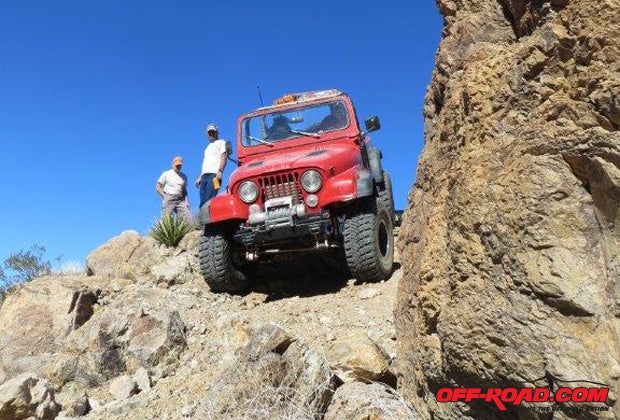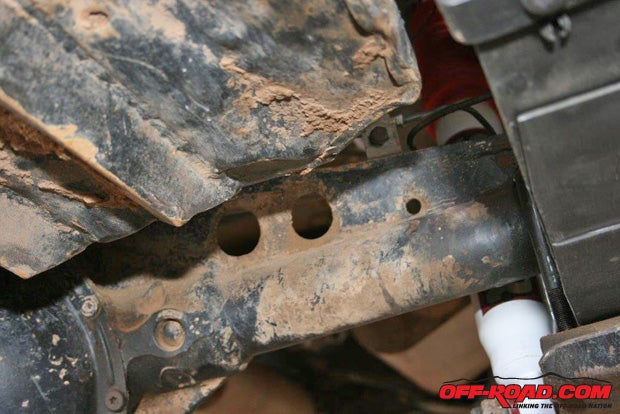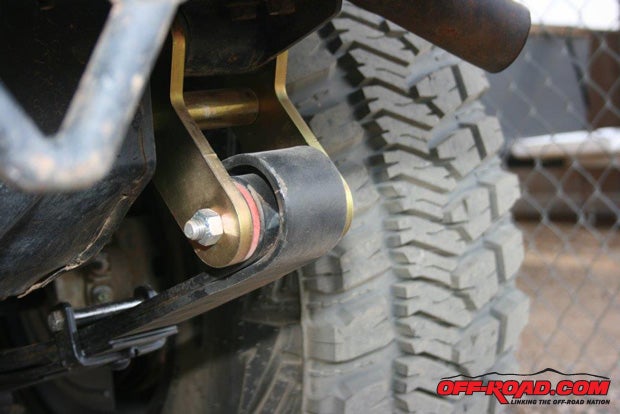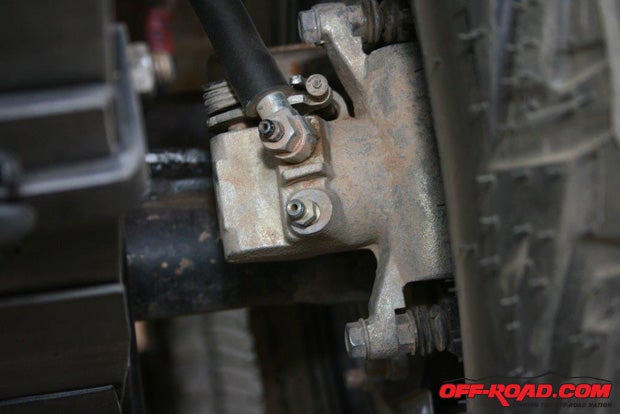
In your Jeep Creep questions, please list your first and last names, your hometown, and your state/province/country, so that we can publish that information here. If you donít provide this information, we may not be able to publish your question and answer. Donít forget to be as complete as possible with the description of your Jeep and its problems, too. Send your Jeep questions to editor@off-road.com, Attn: Jeep Creep.
Previous Jeep Creep Columns
December 2013
13V-483: Chrysler is recalling certain model year 2014 Jeep Grand Cherokee vehicles manufactured January 8, 2013, through August 20, 2013. Due to a disruption of computer communications and loose alternator ground wires, the affected vehicles may experience random illumination of multiple instrument cluster warning lights, loss of cluster illumination and loss of anti-lock brake system (ABS) and electronic stability control (ESC) function. Because of these conditions, the vehicles fail to conform to the requirements of Federal Motor Vehicle Safety Standard (FMVSS) No. 101, ďControls and Displays,Ē and No. 126, ďElectronic Stability Control Systems.Ē A loss of ABS and ESC function reduces the driverís ability to control the vehicle. Drivers would not be warned of brake system failures or any other failures which would be illuminated on the dashboard display. Either condition increases the risk of a crash. Chrysler will notify owners, and dealers will update the ABS and instrument cluster module software and tighten the alternator ground wire, free of charge. The recall began on November 19, 2013. Owners may contact Chrysler at 800-247-9753. Chryslerís recall campaign number is N58.
13V-552: Chrysler is recalling certain model year 2013 Dodge Avenger and Chrysler 200, and model year 2014 Jeep Compass and Patriot vehicles equipped with 2.4L engines. Due to abrasive debris in the balance shaft bearings, these engines may have a loss of engine oil pressure, possibly resulting in an engine stall or engine failure. If the engine stalls while driving it may increase the risk of a crash. Chrysler will notify owners, and dealers will replace the engine balance shaft module, free of charge. The recall began on December 24, 2013. Owners may contact Chrysler at 800-247-9753. Chryslerís recall campaign number is N52.
Building a CJ
Iíve read your recent answer where you list suggestions on how to order a new Jeep Wrangler and I really liked your options. Good job! But they donít help me with my problem. I just got a really good deal on a 1984 Jeep Scrambler, but itís completely stock. It hasnít even been lifted yet, and as far as I can tell it still has the two-piece axles in the rear end. What would you suggest I do to the Scrambler? Iíll be driving it to the trails around home and maybe tow a camping trailer, so I need to keep it street legal. I also want to rock crawl. Iíll be trailering it to events farther away. I plan on taking about two years for the rebuild, so money shouldnít be a problem. But I also want to be able to use it during the two years. In other words, if you had a large budget, what would you do to an í84 Scrambler? And how would you do it so that it could be used between upgrades? By the way, the body is in really good shape. The 4.2 six runs okay, and the five-speed manual transmission works alright (although I think Iíll need a clutch in a few more months). I think it has 3.73 gears (one tag is missing and the other one is messed up so itís hard to read).
Woody Rutledge
Corpus Christi, TX
Wow, Woody, a big budget, a stock Scrambler and a slick slate! Thatís almost too much for a Jeeper to contemplate! In order to make it easier to follow my suggestions Iíll list them by number. Where possible, Iíll also list some manufacturers and/or retailers where the product is available (if the product is in short supply). If there are several suppliers, I wonít mention the names because an Internet search will give you any number of them. In addition, although the specific part for a CJ might differ from the same part for a YJ or a TJófor instance, front springs (i.e., narrow leaf springs for the CJ, wider leaf springs for the YJ, and coil springs for the TJ)óif I suggest a lift kit, a body lift kit, or an engine transplant, the suggestion will work for all three models, just the specific part(s) will be different.
1. Iím assumingósince you say youíll be attending events and doing some rock crawlingóyouíll want larger tires, but Iíll get to that later. First, you should do what I do with every used car Iíve purchased. I change all the hoses, fluids, and belts so that Iím starting fresh. I also check the condition of the brake pads and shoes.
2. Secondly, youíll need stronger axles, more clearance (fender, ground, and frame), and lower gears. If youíre going to use 37-inch or larger tires, youíll want larger differentials than the OEM Dana 30 front and AMC 20 rear. Youíll want at least Dana 44 differentials front and rear; Dana 60s if youíre going to compete. However, I recommend a maximum of 35-inch diameter tires if youíll be driving it on the street for any distancesóyouíll get more miles per dollar than the larger tires and theyíre easier on your running gear. For 35s youíll need to do the following on a CJ: one-piece axles in the rear AMC 20 differentialóthis is one of the weakest points in the Jeepís drivelineó(several makers offer one-piece axle kits, such as Summers Brothers, Alloy USA, G2; check Morris 4x4, 4Wheel Parts, Quadratec, etc.). If the front differential doesnít have free-wheeling hubs, youíll need a pair; they will ease your highway travels. Also I recommend upgrading your front axles with stronger units such as RCV axles. Both OEM differentials should have strengthening trusses welded from the ends of the axle tubes over the pumpkin (see the photo below).

For gears, if you upgrade to a Dana 44 in the rear, Iíd recommend 4.27:1 gear ratio. Unfortunately, 4.27 gears are not available for the AMC 20, so I suggest 4.56:1 gears, which is what I have in my í82 CJ7. Many companies make 4.88 and even lower gears for the Dana 30/AMC 20 combination, but in my opinion the Dana 30 pinion gear for any ratio lower than a 4.56 would be too small to survive for long. Add lockersóselectable in the front Dana 30 and either selectable or permanent lockers in the rearóand youíre finished with the differentials.
3. Moving up the chain of power, the suspension is the next object of our attention. With a TJ or JK you can go quite highó6 to 8 inchesóbecause of the long-arm suspension designs. Even with a YJ (with the wider front springs) you can find 6-inch lift kits, although youíd have to do some expensive and extensive changes to the drivelines if you go that high. Therefore, I recommend a maximum of 4 inches lift for any of the shorter wheelbases. With a Scrambler you could go with a 6-inch lift if you change the front spring shackle mounts to the 2-inch-wide springs youíll find on a YJóavailable through several suppliers. In fact thatís what I did on my Seven more than 20 years ago, and Iíve been enjoying a YJ 4-inch lift suspension ever since. Oddly enough, with the YJ leaf springs you only need to carry one spare spring set for an emergency ďget homeĒ repair because all four springs are the same width and length (although the pumpkin angle shims may be different, but it will get you home should you break a spring on the trail). Several suspension manufacturers offer 4-inch lift kits for CJs, YJs, TJs, and JKs, so you only need to shop for price and reputation. If youíre going to try some of the more technical trails, I also suggest leaf springs with ďmilitaryĒ wraps. This means that there are double leaf wraps around each end of the spring to make it more durable. And donít forget an extended-drop Pitman arm from the steering gear box and extended bump stops so you donít bottom out the new shocks.

4. Tires and wheels: If youíre going to be rock crawling, youíre going to want an open, aggressive tread pattern. For 35-inch-diameter tires, I recommend getting a 12.50 size, which are available in 15-, 16-, 17-, and 18-inch-diameter wheels. If you can afford them, Iíd also suggest bead-lock wheels, although Iím not aware of any bead-locks that are DOT approved for highway use. And 10-inch-wide rims work well with 12.50 tires just be careful of the offset of the wheel so itíll clear your frame and/or body during very tight turns.
5. You may or may not have to extend the driveshafts with a lift. Iíve never experienced a problem with either driveshaft on the CJ7 but Iíve kept the U-joints well-greased. However, I strongly suggest a change to a 4:1 low range in the transfer case. Several manufacturers offer these kits, depending on what model transfer case your Jeep has, including Teraflex. A Dana 300 case comes from Jeep with a 2.79:1 gear ratio, while Rubicons (TJ and JK) have 4:1 low range from the factory. A 4:1 is much safer going downhill by controlling the Jeepís speed. Going uphill can also be accomplished much slower with more control due to the improved gear multiplication.
6. Engine and transmission: Iím a child of the ďfiftiesĒ which means Iím a V8 and automatic transmission fan. The torque advantage of a Chevy small block 350 cannot be overemphasized! Couple it with a GM TH350 three-speed automatic and I can idle over almost any obstacle, lock it in low for those extra steep and super loose downhill slopes so I donít have to ride the brakes, and still have a ball with super-wide paddles in the Glamis dunes. Itís a great all-around setup, but I do have an alternative. One that several people Iíve spoken with on the trails think is the best of all worlds: a Chevy 4.3L V6 and a GM 700R4 automatic transmission. With a Scrambler, Woody, you have more than enough wheelbase to accommodate the longer transmission, and if you prefer a new engine to a refurbished used one, Summit Racing offers a crate 4.3L with 262 horsesówhich is interesting because thatís also the engines cubic-inch displacement (262 CID)óalthough youíll need a donor motor for all the accessories and necessities like alternator, ignition system, fuel injection, etc.
7. Of course, youíll need at least a 9,000-pound winch, full-cage roll bar, new seats and seat belts, and auxiliary lights. You may also want to upgrade the brakes with disc brakes instead of the rear drum brakes.
There you have it, Woody, my list of goodies for the complete CJ (or YJ or TJ).
Bleeding Stainless Steel Brakes
Several years I had a disc brake kit from Stainless Steel Brakes installed on my CJ. Theyíve worked great for all these years. However, I recently changed my flexible brake hoses and bled all four brakes. But my pedal still feels soft and mushy. I no longer have the installation instructions so I canít figure out if Iím bleeding the brakes right. Iíve been bleeding brakes for years with no problem but I canít figure these out. Can you help me? If not, Iíll have to find out how to contact Stainless Steel Brakes or find a shop around here than knows Jeeps.
Frank Magnum
Oklahoma City, OK

Stainless Steel Brakes (http://ssbrakes.com) uses a GM-style caliper (see photo) from a pickupís front axle. And even though itís equipped with two bleeder valves, you have to use the lower valve when the caliper is mounted. What you must do is remove the rear calipers, use the proper size block of wood between the brake pads (to simulate the disc), and bleed the brakes in the normal fashion while holding the calipers upside-down. This puts the previously mentioned valve on top, which allows the air to escape the lines. Remove the wood and reinstall the calipers.
Rotopax Containers
Where can I get those Rotopax holders that mount to the PSC rear bumper? I cannot find them on the RRM website.
I wish youíd left an address and name. Iím afraid youíll have to build your racks for the Rotopax (http://rotopax.com/Pack-Mount.html) containers. However, you can buy the locking mounts from Rotopax, Amazon, 4Wheel Parts, etc. You would then mount them on the racks to hold the containers in place.
Bad Ignition
I have an Ď85 CJ7 with a 4.2L engine and manual tranny. The engine spins over but will not start. Sometime it hits once I let off the key. I have changed the ignition switch control module, the coil, the distributor cap, the rotor, and the distributor. Help!! I am a first time user of your site.
Steve
Check for voltage on the plus (+) side of the coil when cranking. If it has voltage, measure how much, then check for pulsing voltage on the minus (-) side of the coil when cranking. It could also be a possible bad coil. Look in a repair manual for a wiring diagram for the proper ignition circuit during cranking. (I once had a tachometer that caused this one timeórare but possible.) It should have at least 10 volts at the coil during cranking. It could also be a bad starter solenoid or bad wiring from the ignition side of the solenoid (on one of the two small posts). If it has only one small post then cold crank voltage is through the ignition switch.
As usual, each month, Iím shouting out a huge THANK YOU to Paul Schupp at Rock Lizard 4x4 in Kingman, Arizona, for his invaluable assistance in answering many of the Jeep Creep questions.
In your Jeep Creep questions, please list your first and last names, your hometown, and your state/province/country, so that we can publish that information here. If you donít provide this information, we may not be able to publish your question and answer. Donít forget to be as complete as possible with the description of your Jeep and its problems, too. Send your Jeep questions to editor@off-road.com, Attn: Jeep Creep.
Previous Jeep Creep Columns
December 2013


 Your Privacy Choices
Your Privacy Choices